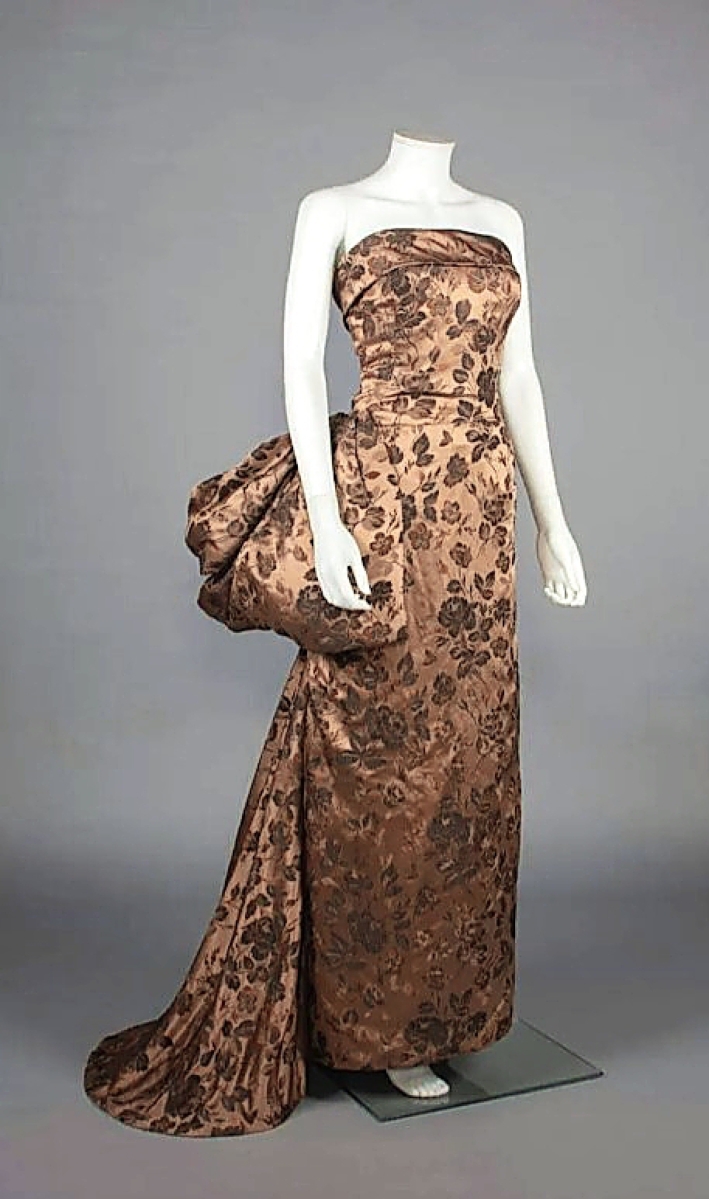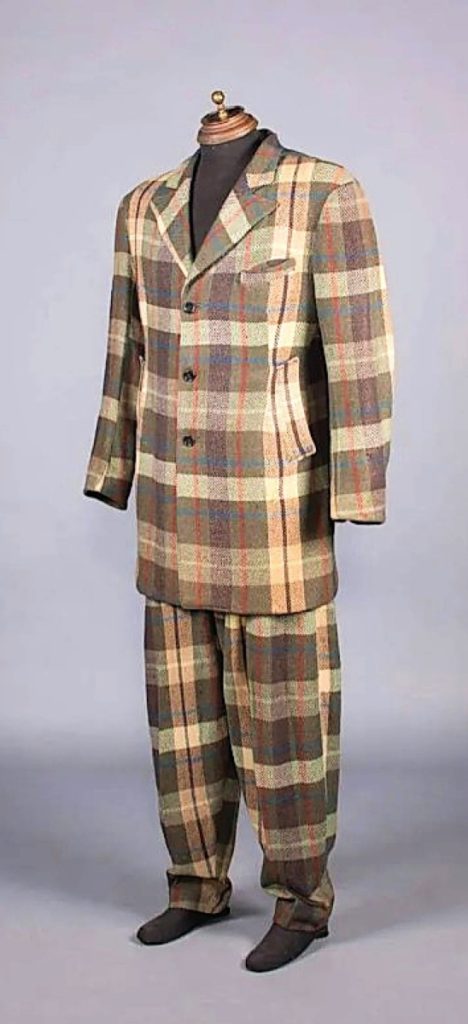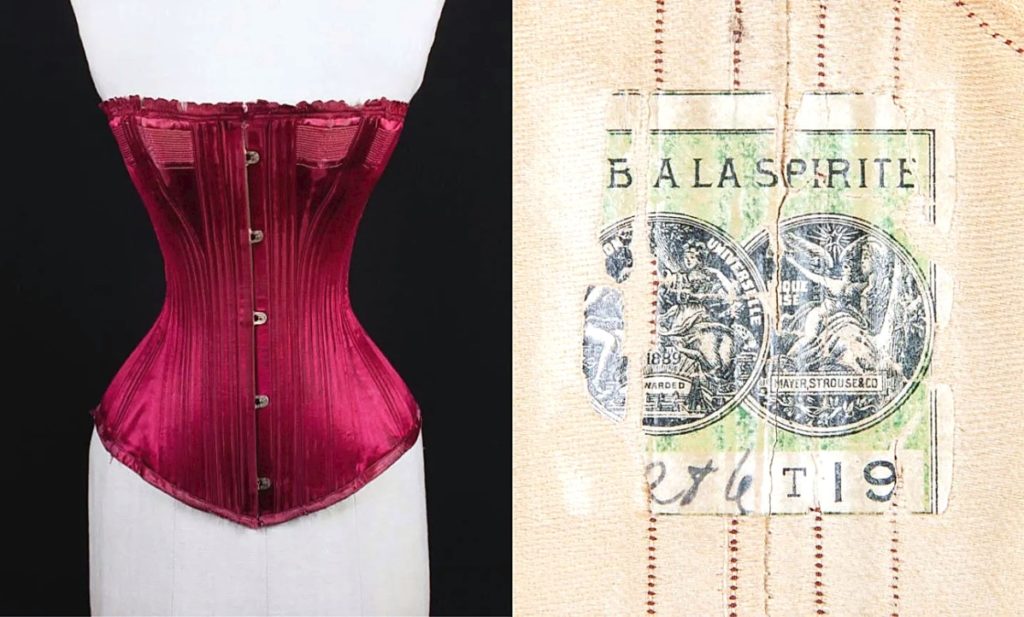
Asymmetrical satin brocade ball gown by Christian Dior New York, the second top lot in the sale that bid to $8,750 ($4/6,000).
Review by Z.G. Burnett, Photos Courtesy of Augusta Auctions
BELLOWS FALLS, VT. – Augusta Auctions’ December 7 Decades of Decadence sale offered 250 lots of antique and vintage garments, textiles and a few related collectibles. The top lots spanned two centuries of fashion, with only their age or century being a common factor between the diverse objects. The sale totaled $172,500 with a buy-through rate of 91 percent.
Two lots tied for the highest selling spot in this auction, similar in age yet worlds apart in style. The first in the listings was a plaid wool zoot suit cataloged as 1940s. Zoot suits may be the stuff of cartoon characters today but in their time, these oversized but deliberately tailored ensembles were originally costumes that became anti-establishment fashion statements. Comedian Ernest “Skillet” Mayhand (1916-2007) is credited with creating the zoot suit for his act in the 1930s and the style was popularized by bandleader and singer Cab Calloway (1927-1994). Zoot suits were later popular with Chicano youth culture in southern California, as well as other Hispanic and Latino American communities. Media portrayal of the suits as gang wear escalated racial tensions that exploded into the Zoot Suit Riots of the early 1940s, when textiles were rationed for the war effort and the baggy style was considered unpatriotic. Consigned from the collection of Baltimore costumers A.T. Jones & Sons, the suit was acquired by an American institution for $8,750.
The second winning lot was a ball gown with the New York label of couturier Christian Dior (1905-1957), also achieving $8,750 from an international bidder. Dior’s “new look” is characterized by a structured bodice, a nipped-in waist and a voluminous skirt designed to best accentuate the traditional female form. This late example in Dior’s career from 1955 plays with these hallmarks, showing a slender skirt with an asymmetrical hip embellishment and train, draped in copper satin brocade. The catalog includes a reference photo from defunct department store Bonwit Teller, arranged by West Side window dressing service and photography studio Virginia Roehl, Inc, which was not included in the sale.

Garnering significant interest and vigorous bidding, this rare example of a zoot suit in fair/good condition was one of two tied top lots at $8,750 ($1,2/1,500).
Attire from almost every decade of the Nineteenth Century was popular in this sale, but the highest selling was an award-winning À la Spirite corset in claret satin at $4,500. Dated to circa 1893, the corset was awarded gold medals at the Chicago Exposition in 1893 and at Paris Exposition in 1889. With a waist less than half the size of its hips and bust, the corset is a dangerously seductive example of this era’s extreme and ultimately harmful shapewear standards. Lined with cotton twill, the corset was in good condition with evidence of wear but was no less luminous for its age.
The earliest lot towards the top of the list was a circa 1820 silk pelisse inspired by the earlier styles shown in paintings by Anthony van Dyck (Belgian, 1599-1641). Made with a patterned silk base, the pelisse was edged with robin’s egg blue satin appliqués trimmed with silk cord, silk thread and decorative buttons. From the Ohio State Costumes & Textiles Collection, it was in fair condition with signs of restoration and sold for $2,750. Slightly later but still referential of the Seventeenth Century was a black silk twill mourning dress, circa 1830. With big gigot sleeves and a standing collar, the dress was in good condition and consigned from the Museum of History & Industry, Seattle, Wash.; it bid to $2,000.
An example of contemporary 1860s fashion was offered in a two-piece bone silk taffeta evening gown, trimmed in robin’s egg blue velvet and blonde silk lace around the bust line. The trained waist expanded with a deeply pleated skirt, featuring a box pleated spiraled velvet ribbon rosette securing two velvet-edged sash ends. The gown was also from the Ohio State Historic Costumes & Textiles Collection and showed wear concurrent with age, but was cataloged as in good or very good condition and sold for $1,875.
Nineteenth Century daywear also did well. Two taffeta day dresses multiplied their estimate to $3,250, each exhibiting the different silhouettes popular during the 1880s. One maroon silk taffeta dress in a chinoiserie pattern was comprised of three pieces with a matching handbag, and the other was a two-piece grey silk taffeta dress. The maroon dress showed a high bustle with a close-fitting skirt and the grey dress had a bell-shaped silhouette with ruffles on the hem. Each jacket also framed the form in a different way. Both bodices were in good condition, but the skirts were poor, which follows with these dresses being garments that were actually worn. A related lot from the 1890s was a wool twill sporting ensemble, which must have been owned by a lady of leisure because it was in excellent condition and sold for $1,875.

This award-winning, sultry satin corset showed some signs of wear on its delicate exterior but was reinforced by its still-strong boning; it was the highest priced Nineteenth Century garment at $4,500 ($1/1,500).
The winning lots moved into the Twentieth Century with a shining selection of Aesthetic Movement garments. The first on the price list was a three-piece silk pongee day dress from the late 1910s, embroidered with floss silk at the edges, that could be worn in multiple ways and achieved $1,875. More dramatic was a gold silk satin evening cloak from the same era with metallic embroidered bands at the neckline and sleeves, terminating in rear tassels. This beauty also came from the A.T. Jones & Sons collection and expanded to $1,815. A little later chronologically was a silk taffeta cape from Paris couturier Paquin that arrived at $1,940.
A marked departure from the heavily structured garments of the Nineteenth Century was a three-piece hammered silk evening ensemble from the 1930s. The bias-cut dress appears almost as pale pink liquid, with a gathered neckline, broad and corded bands comprising the loose-fitting bodice and a cummerbund-style band. Accompanying the dress was a rabbit fur-trimmed cape. Both were in excellent, wearable condition and the ensemble sold for $2,065.
Prices quoted with buyer’s premium as reported by the auction house. Augusta Auctions’ next sale, Wonders For Your Wardrobe, will occur on February 22. For information, 802-463-3333 or www.augusta-auction.com.




















